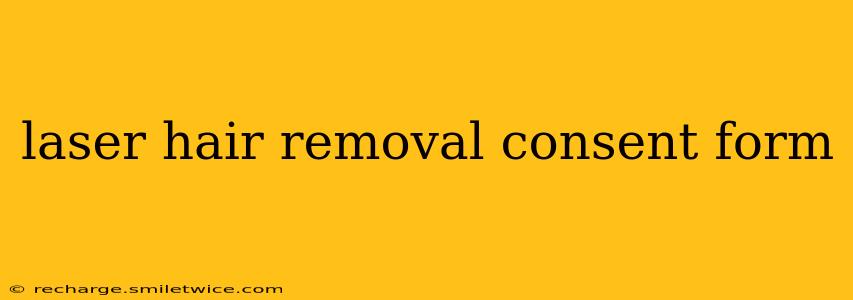Laser hair removal is a popular cosmetic procedure, but it's crucial to understand the process and potential risks before undergoing treatment. A well-structured consent form is the cornerstone of a safe and informed procedure. This guide explores the key elements of a comprehensive laser hair removal consent form and provides insights for both patients and practitioners.
What Should a Laser Hair Removal Consent Form Include?
A robust consent form protects both the patient and the practitioner. It ensures the patient understands the procedure, its benefits, and potential risks, while also safeguarding the practitioner from potential legal issues. Here's what a comprehensive form should contain:
1. Patient Information:
- Full Name: Accurate identification is paramount.
- Date of Birth: Helps verify identity and assess suitability for treatment.
- Address: For contact and record-keeping purposes.
- Phone Number and Email: Essential for communication regarding appointments, follow-up care, and any unforeseen issues.
2. Procedure Details:
- Type of Treatment: Clearly state "Laser Hair Removal." Specify the type of laser used (e.g., Alexandrite, Diode, Nd:YAG) as different lasers have varying effects and suitability for different skin types.
- Treatment Area: Precisely define the area(s) to be treated (e.g., upper lip, underarms, bikini line, full legs).
- Number of Sessions: Estimate the number of sessions required for optimal results. Emphasize that this is an estimate and individual results may vary.
- Cost and Payment Plan: Transparency regarding the financial aspect of the treatment is vital.
3. Informed Consent:
This section is crucial. It should clearly explain the following:
- Benefits of the Procedure: Describe the expected results, such as long-term hair reduction.
- Risks and Potential Side Effects: This is perhaps the most important aspect. The form should list potential side effects, including but not limited to:
- Pain or Discomfort: Explain the level of discomfort patients can expect, and the pain management options available.
- Redness and Swelling: These are common temporary side effects.
- Blistering or Crusting: Less common, but possible side effects.
- Hypopigmentation or Hyperpigmentation: Changes in skin color. Explain the risk factors associated with these changes (e.g., sun exposure).
- Infection: While rare, the possibility of infection should be addressed.
- Scarring: Though uncommon with proper technique, the possibility should be mentioned.
- Allergic Reactions: Explain the possibility of reactions to any topical anesthetics or other products used.
- Contraindications: Clearly outline any conditions that would make the patient unsuitable for laser hair removal, such as:
- Pregnancy or Breastfeeding: Hormonal changes during these periods can affect treatment results and potentially cause complications.
- Active Infections or Skin Conditions: Existing skin problems can complicate treatment and increase the risk of complications.
- Certain Medications: Some medications can increase the risk of side effects.
- Recent Tanning: Explain the importance of avoiding sun exposure before and after treatment.
- Alternative Treatments: Mention alternative hair removal methods (e.g., electrolysis, shaving, waxing).
- Aftercare Instructions: Provide clear instructions on how to care for the treated area after the procedure. This often includes avoiding sun exposure, using specific creams, and keeping the area clean and dry.
4. Patient's Acknowledgment:
This section requires the patient's signature and date, confirming they have:
- Read and understood the information provided in the consent form.
- Had all their questions answered to their satisfaction.
- Freely and voluntarily consent to the procedure.
- Understand that results may vary.
- Agree to follow all aftercare instructions.
What Happens If I Don't Understand Something on the Form?
If you are unsure about any part of the consent form, do not hesitate to ask your practitioner for clarification. A reputable clinic will be happy to answer all your questions and ensure you are fully informed before proceeding with the treatment.
Is a Laser Hair Removal Consent Form Legally Binding?
Yes, a properly completed and signed consent form serves as legal documentation indicating the patient's informed consent to the procedure. It protects both the patient and the practitioner from potential legal disputes.
This comprehensive guide provides a thorough understanding of the essential components of a laser hair removal consent form. Remember, informed consent is key to a safe and successful treatment.
